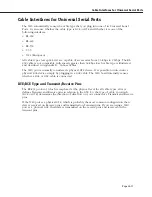
Introduction
Page 28-2
Type of Service (ToS)
The Type of Service (ToS) settings allow you to prioritize voice data and voice signaling data.
Since voice data is time critical, and requires steady throughput, it should be given higher
priority than other forms of data. This can be done by assigning a priority value for the Voice
Data and Voice Signaling Data fields.
There are two methods of specifying the ToS priority: IP Precedence and Differentiated
Services Code Point (DSCP). Both of these methods use a binary value to indicate priority. IP
Precedence uses three bits, and DSCP uses six bits; therefore the values for IP Precedence
range from 0 to 7, and the values for DSCP range from 0 to 63. The higher the number, the
higher the priority of the traffic. IP Precedence uses the most significant (upper) 3 bits, and
DSCP uses the most significant (upper) 6 bits.
♦
Important Note
♦
The ToS setting is a feature of Quality of Service (QoS).
It was set into the UI to make Voice over IP (VoIP)
modules compatible with an Omni Switch/Router that
does not have QoS installed. If the QoS image is
installed (
qos.img
) on the switch, the UI ToS commands
do not function. They are overridden by standard QoS
functionality.
Currently, the defaults set for voice data and signaling data are the setting recommended by
both Alcatel and Cisco. The default values for switches use hexadecimal forms of IP
Precedence; the default value for voice data is 5 decimal, and the default value for signaling is
3 decimal.
Below is a table that shows the relation of IP Precedence levels and DSCP levels.
Relation of IP Precedence, DSCP, and Level of Priority
Priority Level
IP Precedence
Value (Decimal)
DSCP Value Range
(Decimal)
Routine
0
0 - 7
Priority
1
8 - 15
Immediate
2
16 - 23
Flash
3
24 - 31 (AF31)
Flash-Override
4
32 - 39
Critical
5
40 - 47 (EF)
Internet
6
48 - 55
Network
7
56 - 63
Summary of Contents for Omni Switch/Router
Page 1: ...Part No 060166 10 Rev C March 2005 Omni Switch Router User Manual Release 4 5 www alcatel com ...
Page 4: ...page iv ...
Page 110: ...WAN Modules Page 3 40 ...
Page 156: ...UI Table Filtering Using Search and Filter Commands Page 4 46 ...
Page 164: ...Using ZMODEM Page 5 8 ...
Page 186: ...Displaying and Setting the Swap State Page 6 22 ...
Page 202: ...Creating a New File System Page 7 16 ...
Page 270: ...Displaying Secure Access Entries in the MPM Log Page 10 14 ...
Page 430: ...OmniChannel Page 15 16 ...
Page 496: ...Configuring Source Route to Transparent Bridging Page 17 48 ...
Page 542: ...Dissimilar LAN Switching Capabilities Page 18 46 ...
Page 646: ...Application Example DHCP Policies Page 20 30 ...
Page 660: ...GMAP Page 21 14 ...
Page 710: ...Viewing the Virtual Interface of Multicast VLANs Page 23 16 ...
Page 722: ...Application Example 5 Page 24 12 ...
Page 788: ...Viewing UDP Relay Statistics Page 26 24 ...
Page 872: ...The WAN Port Software Menu Page 28 46 ...
Page 960: ...Deleting a PPP Entity Page 30 22 ...
Page 978: ...Displaying Link Status Page 31 18 ...
Page 988: ...Displaying ISDN Configuration Entry Status Page 32 10 ...
Page 1024: ...Backup Services Commands Page 34 14 ...
Page 1062: ...Diagnostic Test Cable Schematics Page 36 24 ...
Page 1072: ...Configuring a Switch with an MPX Page A 10 ...
Page 1086: ...Page B 14 ...
Page 1100: ...Page I 14 Index ...
















































